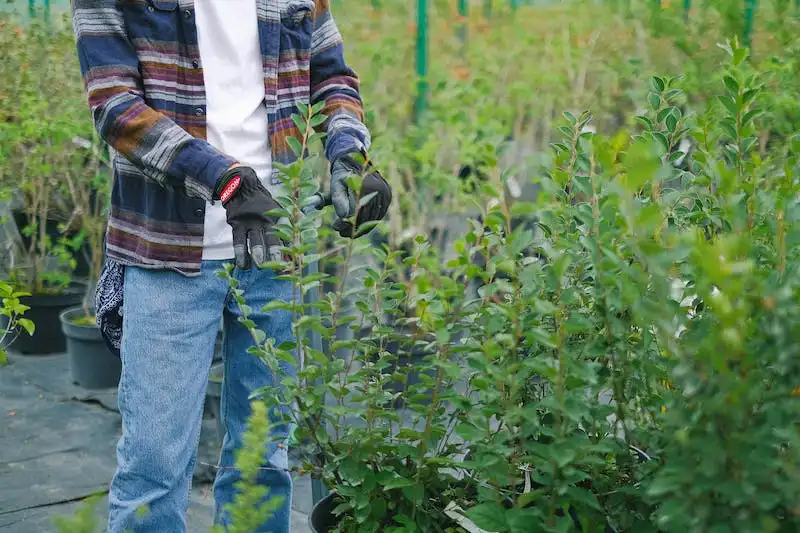Are you a home gardener who loves growing herbs? If so, you’ve probably experienced the bountiful harvests that these plants can produce. However, once you have an abundance of herbs, it’s important to know how to properly harvest and preserve them in order to enjoy their freshness for a longer period of time.
When it comes to harvesting herbs, timing is crucial. The best time to harvest herbs is in the morning, before the heat of the day causes them to wilt. For herbs like rosemary and basil, you can start snipping off the tips of the branches as soon as they are about one-third to one-half of their total length. This will encourage the plant to grow more bushy and yield a larger harvest.
Once you have harvested your herbs, it’s important to handle them with care to maintain their quality. Remove any damaged or discolored leaves, and wash them gently under running water to remove any dirt or insects. If you’re not planning to use the herbs right away, there are several methods for preserving them.
One popular method is to store the herbs in the freezer. Simply place the clean, dry herbs in a plastic bag or an airtight container and freeze them. This method works well for herbs like oregano, thyme, and mint, which can be used in stews and soups without thawing. Just remember to label the container with the herb’s name and the date it was frozen.
Another option is to dry the herbs for later use. Hang the sprigs upside down in a dry, well-ventilated area away from direct sunlight. Once the herbs are completely dry, you can store them in airtight containers. This method works well for herbs like basil and chives, which can be added to dishes during cooking.
By following these tips on harvesting and preserving herbs, you can enjoy the flavors and aromas of your homegrown herbs all year round. So get started on your herb garden and start enjoying the benefits of fresh herbs in your cooking!
Growing, Harvesting, and Preserving Herbs
When it comes to growing, harvesting, and preserving herbs, there are several techniques and methods you can use. Whether you have limited space or a large garden, herbs can be grown both indoors and outdoors. Here are some tips and tricks to help you become a master herb gardener.
First, it’s important to pick the right herbs for your garden. Some popular choices include chives, oregano, mint, rosemary, and basil. These herbs have a wide range of flavors and can be used in various recipes, from soups and salads to cocktails and desserts.
If you’re just getting started, you can buy herb plants from a reputable seller or start from seeds. Keep in mind that some herbs are perennials, which means they will come back year after year, while others are annuals and need to be replanted.
Once you have your herbs planted, it’s crucial to provide them with the right conditions for optimal growth. Most herbs prefer full sunlight, at least four hours a day. They also need well-draining soil and regular watering.
When it comes to harvesting your herbs, the best time to do so is in the morning after any dew has dried. Use clean, sharp scissors or shears to snip the stems just above the base. This technique prevents the plant from becoming damaged and allows for faster regrowth.
Now that you have harvested your herbs, it’s time to preserve them for future use. One popular method is freezing. Simply wash and dry the herbs, remove any woody stems, and place them in airtight containers or freezer bags. Label and date the containers and store them in the freezer. This method allows you to enjoy fresh herbs throughout the year.
Another technique uses drying to preserve herbs. Bundle the herbs together and hang them upside down in a cool, dry, and dust-free room. Once the herbs have dried completely, you can remove the leaves from the stems and store them in airtight containers. Dried herbs can be used in cooking, teas, or for homemade potpourri.
Some herbs, like basil and parsley, can also be stored in water. Simply place the stems in a glass of water, like a bouquet, and keep them in a well-lit area. This method keeps the herbs fresh for a longer period.
It’s important to note that the flavor of herbs may diminish over time, so try to use them within a year of harvesting. If you notice any signs of mold or a strange odor, discard the herbs. Additionally, avoid exposing the herbs to sunlight or heat, as it can cause them to lose flavor and color.
In conclusion, growing, harvesting, and preserving herbs can be a rewarding and enjoyable process. By following the right techniques, you can have a bountiful yield of fresh herbs for all your culinary adventures.
Propagation and Cultivation
When it comes to propagating and cultivating herbs, there are a few important steps to follow. First, make sure to choose a suitable setting for your herbs. They thrive in areas that receive at least six hours of sunlight per day.
To propagate herbs, you can snip off one-third of the stems before using them. This will encourage new growth and facilitate a more productive harvest.
Before drying herbs, remove any thick stems and pods, as they can retain moisture and cause mold. Instead, focus on the foliage, which contains the important oils and flavors.
If you prefer to use fresh herbs, storing them in containers with slightly moistened organic material can help preserve their quality for longer.
For perennial herbs like oregano and mints, pruning them back to their base in early spring will promote bushy growth and prevent them from becoming too leggy.
When it comes to preserving herbs, there are many techniques to learn. For example, you can dry them by hanging them upside down in a warm, well-ventilated area. Alternatively, you can freeze them by washing and chopping the herbs, then placing them in ice cube trays covered with water.
Regardless of the method you choose, make sure to store your harvested herbs in airtight containers to prevent them from losing their potency.
It’s also worth noting that different herbs have different habits and heights. For example, oregano has a rigid growth habit and can reach a height of up to two feet, while parsley tends to be more bushy and grows to a height of one foot. Knowing the specific characteristics of each herb will help you make the most of your garden’s bounty.
Finally, when it comes to harvesting herbs, timing is crucial. Harvest herbs in the morning after the dew has dried, but before the heat of the day sets in. This is when their oils are most concentrated, ensuring maximum flavor and aroma.
Harvesting
When harvesting herbs, it’s best to remove foliage from the plant early in the morning. This is when the herbs have the highest level of essential oils, which contribute to their taste and aroma. It’s also important to harvest herbs before they start flowering, as flowering can decrease the potency and flavor of the foliage.
Annual herbs, such as basil and parsley, can be started from seed each year. Harvest the herbs by snipping off the top one-third of the plant, just above a set of healthy leaves. This will encourage the plant to produce more foliage and delay the onset of flowering.
Perennial herbs, like rosemary and oregano, can be harvested year-round. Cuttings should be taken from the top of the plant and used fresh or dried for later use. To store rosemary and oregano, strip the leaves from the stem and place them in bags. Make sure to shake the bags to remove excess moisture before storing. The herbs can be stored in a cool, dark place for up to four months.
When drying herbs, it’s important to preserve their flavor and color. To do this, hang the herbs in bundles in a cool, dry location. Once the herbs are dry, remove the leaves from the stems and store them in airtight containers. Label the containers with the name of the herb and the date of drying. Stored herbs should be used within one year for maximum flavor.
For quick uses, herbs can be frozen in ice cube trays with water or oil. Another option is to puree fresh herbs with a bit of water or oil and freeze them in ice cube trays. These herb cubes can then be added directly to soups, stews, and other dishes for added flavor.
Herb runners, such as mints, can be propagated by removing the plants from the base and replanting them elsewhere in the garden. This is a great way to expand your herb production without having to start from seed.
In conclusion, harvesting and preserving herbs is a simple and rewarding process. By following these guidelines, you can enjoy the benefits of fresh herbs throughout the year.
Preserving and Storing
When it comes to preserving and storing herbs, there are a few useful tips to keep in mind to ensure maximum flavor and longevity. Whether you’ve harvested herbs from your garden or bought them from a seller, these guidelines will help you make the most of your herbaceous bounty.
For starters, it’s important to know that not all herbs can be preserved and stored in the same way. Some herbs, such as rosemary and ginseng, are best preserved by drying them. Simply tie them in small bunches and hang them upside down in a warm, dry place. Once they’re completely dry, you can store the dried herbs in airtight containers.
On the other hand, herbs like mint and oregano can be easily preserved by freezing them. Wash and dry the herbs thoroughly, then chop or leave them as whole sprigs. Place them in airtight containers or freezer bags and store them in the freezer. This method will help preserve the flavor and aroma of the herbs.
Another technique for preserving herbs is by storing them in oil. Rosemary, for example, can be stored in olive oil. Remove the leaves from the stem and place them in a jar, then cover them with olive oil. This not only helps preserve the herbs but also infuses the oil with their flavors.
When storing herbs indoors, it’s important to choose the right location. A cool, dry, and dark room is ideal for keeping herbs fresh for longer. You can also place them in a window setting, as long as they are protected from direct sunlight. This way, you can enjoy your fresh herbs all year round.
It’s worth noting that the timing of the harvest plays a role in the flavor and aroma of the herbs. Generally, it’s best to harvest in the morning, when the essential oils are at their peak. Also, be sure to pick the herbs before they reach their maximum height, as this is when they are most flavorful.
When it comes to storing herbs, it’s important to prevent them from getting dusty. A simple shake or wipe with a clean cloth can easily remove any dust that may have settled on the leaves. Additionally, storing herbs in airtight containers or zip-top bags will help keep them fresh and free from moisture.
Whether you’re preserving herbs through drying, freezing, or oil storage, it’s important to label and date your containers. This will help you keep track of how long the herbs have been stored, and ensure that you use the oldest ones first.
In conclusion, preserving and storing herbs is a quick, simple process that can allow you to enjoy the flavor and aroma of your herb garden all year round. By following these guidelines, you can ensure that your herbs stay fresh, flavorful, and ready for your culinary creations.




